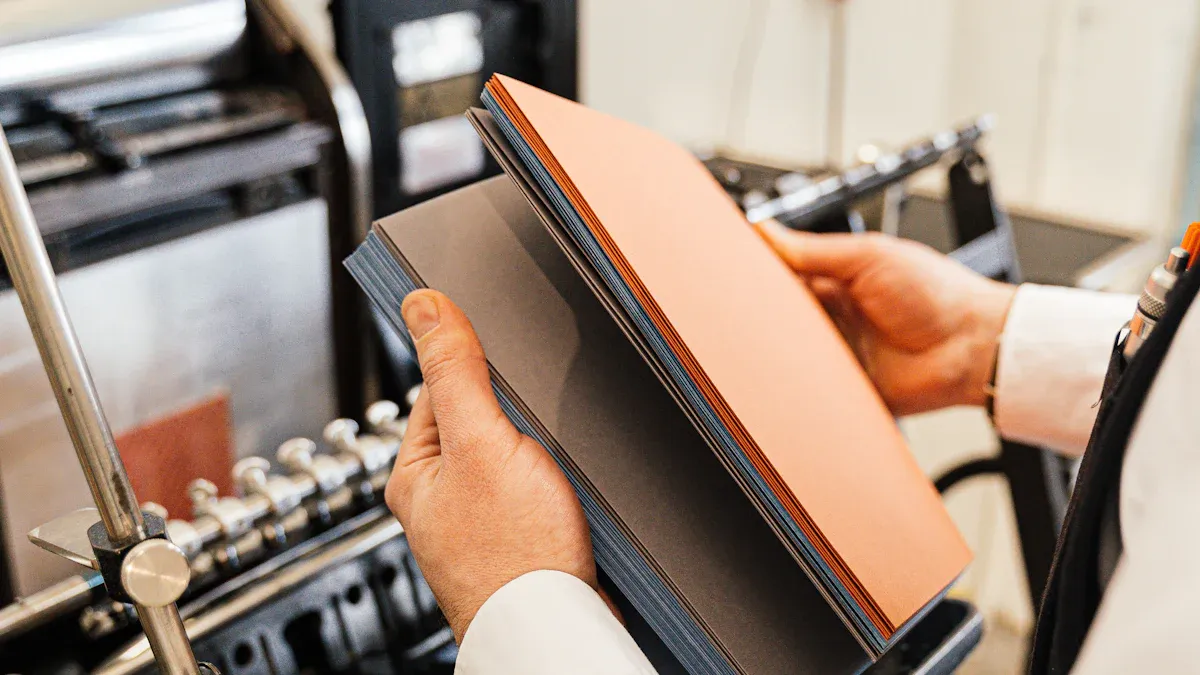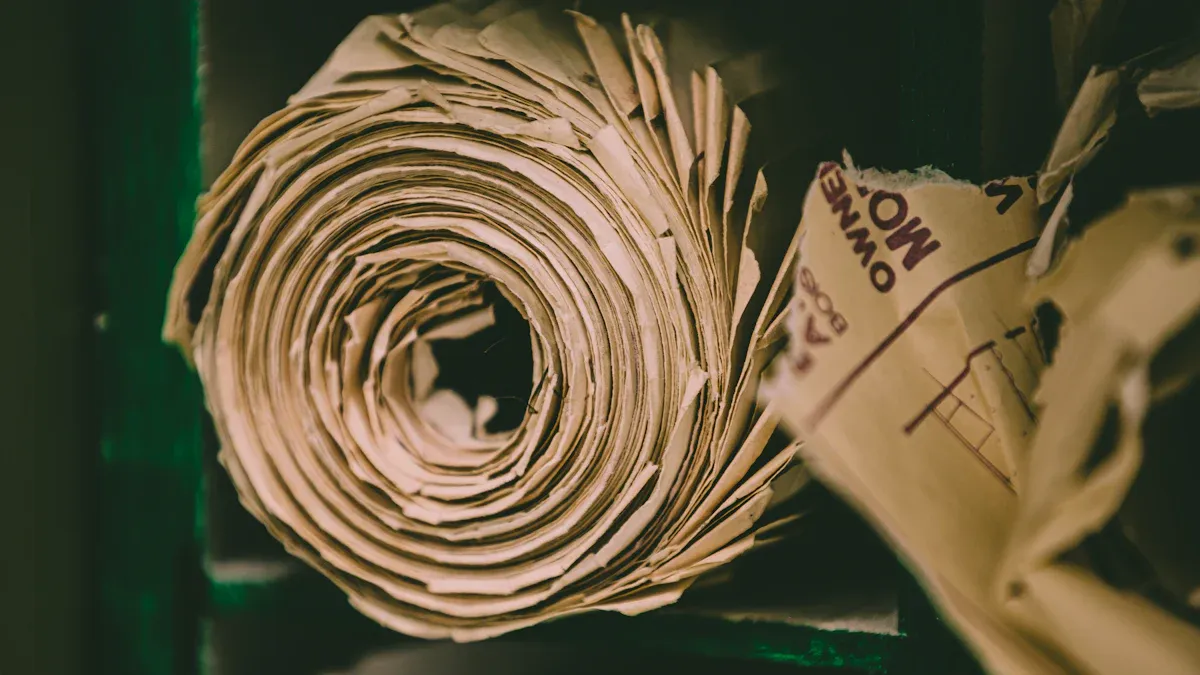
Woodfree Offset Paper stands out in 2025 for its remarkable benefits. Its ability to deliver sharp print quality makes it a favorite among publishers and printers. Recycling this paper reduces environmental impact, aligning with global sustainability goals. The market reflects this shift. For instance:
- The global Woodfree Uncoated Paper market is projected to grow at a 4.1% CAGR by 2030.
- Europe’s packaging sector saw a 12% rise in using this paper over the last two years.
Its cost-effectiveness further boosts its demand, as Offset Paper Reels and Offset Printing Bond Paper offer budget-friendly solutions for modern printing needs.
What Is Woodfree Offset Paper?
Definition and Composition
Woodfree Offset Paper is a specialized type of paper designed for offset lithography printing. It is widely used for producing books, magazines, brochures, and other high-quality printed materials. Unlike traditional wood pulp paper, this paper is made using chemical pulp. The process removes most of the lignin, which is a natural component of wood that can cause yellowing over time. This results in a crisp, white appearance that enhances print clarity.
The production process involves cooking wood chips in a chemical solution. This breaks down the lignin and separates the cellulose fibers, which are then processed into durable and smooth paper. The absence of lignin not only improves the paper’s longevity but also makes it more resistant to discoloration.
| Definition of Woodfree Offset Paper | Market Adoption Insights |
|---|---|
| Woodfree Offset Paper is a type of paper used in offset lithography for printing various materials such as books, magazines, and brochures. | The Global Offset Paper Market report provides insights into the adoption rates and trends in the market. |
Unique Characteristics
Woodfree Offset Paper stands out for its unique features. Its smoother surface ensures excellent printability, making it ideal for high-resolution images and sharp text. The paper’s durability and resistance to yellowing make it a preferred choice for long-lasting printed materials.
Some key characteristics include:
- It is produced using chemical pulp, which removes most of the lignin.
- The paper has a crisp white appearance, enhancing visual appeal.
- Its smooth surface ensures better ink absorption and print quality.
- It offers durability and longevity, making it suitable for archival purposes.
These qualities make Woodfree Offset Paper a reliable option for industries that demand precision and quality in their printed products.
Comparing Woodfree Offset Paper to Other Paper Types
Composition and Manufacturing Differences
Woodfree Offset Paper differs significantly from wood-containing papers in its composition and production process. While wood-containing papers retain lignin, a natural component of wood, Woodfree Offset Paper undergoes a chemical pulping process that removes most of the lignin. This makes it more resistant to yellowing and aging.
The manufacturing process also gives Woodfree Offset Paper a smoother surface and higher durability. Wood-containing papers, on the other hand, often have a coarser texture due to the presence of lignin and other impurities. These differences make Woodfree Offset Paper a better choice for high-quality printing and long-lasting materials.
Printability and Performance
When it comes to printability, Woodfree Offset Paper outshines its counterparts. Its smooth surface ensures excellent ink absorption, resulting in sharp and vibrant prints. This makes it ideal for projects requiring high-resolution images and precise text.
To better understand its performance, here’s a comparison:
| Parameter | Woodfree Offset Paper | Wood-containing Papers |
|---|---|---|
| Opacity | Higher (95-97%) | Lower |
| Bulk | 1.1-1.4 | 1.5-2.0 |
| Ink Absorption | Lower (less dot gain) | Higher (more dot gain) |
| Smoothness | High | Variable |
| Dusting Tendency | Low | High |
| Ageing Resistance | High | Low |
The table highlights how Woodfree Offset Paper excels in key areas like opacity, smoothness, and ink absorption. Its lower dusting tendency also reduces maintenance needs for printing equipment, making it a practical choice for printers.
Environmental Impact
Woodfree Offset Paper aligns with modern sustainability goals. Its production process uses chemical pulping, which allows for better recycling and reduces the environmental footprint. By removing lignin, the paper becomes more durable, extending its lifecycle and reducing waste.
In contrast, wood-containing papers degrade faster due to lignin, leading to higher disposal rates. Many industries now prefer Woodfree Offset Paper for its eco-friendly properties, especially as global demand for sustainable materials continues to rise.
Tip: Choosing Woodfree Offset Paper not only enhances print quality but also supports environmental conservation efforts.
Benefits of Woodfree Offset Paper in 2025

Advancements in Manufacturing
The manufacturing of Woodfree Offset Paper has seen significant improvements in 2025. Modern techniques now focus on efficiency and sustainability. Manufacturers have adopted advanced chemical pulping methods that reduce waste and energy consumption. These innovations ensure the paper maintains its high quality while minimizing its environmental footprint.
Automation has also played a key role. Automated systems streamline production, reducing errors and improving consistency. This means every sheet of Woodfree Offset Paper meets the same high standards, making it a reliable choice for printers and publishers.
Additionally, the use of alternative raw materials, such as agricultural waste and recycled fibers, has increased. This shift not only conserves natural resources but also supports the growing demand for eco-friendly products.
Did you know? The rise of digital printing technology has further enhanced the compatibility of Woodfree Offset Paper with modern printing needs.
Sustainability and Environmental Goals
Woodfree Offset Paper aligns perfectly with global sustainability goals. Its production process prioritizes environmental conservation by reducing the need for virgin wood pulp. This helps protect forests and ecosystems.
Here’s a quick look at its sustainability achievements:
| Sustainability Achievement | Description |
|---|---|
| Conservation of Forests | Reduces demand for wood pulp, helping to conserve forests and protect ecosystems. |
| Decreased Deforestation | Utilizes alternative fibers, minimizing the need for large-scale deforestation. |
| Decreased Carbon Footprint | Manufacturing emits fewer greenhouse gases and consumes less energy and water. |
| Waste Reduction and Recycling | Often made from recycled materials, supporting recycling initiatives and reducing landfill waste. |
| Alignment with Sustainability Goals | Contributes to UN SDGs related to responsible consumption (SDG 12) and life on land (SDG 15). |
The growing use of recycled materials and agricultural waste in production further highlights its eco-friendly nature. By reducing reliance on virgin pulp, Woodfree Offset Paper helps lower carbon emissions and supports a circular economy.
Cost-Effectiveness for Modern Printing
In 2025, Woodfree Offset Paper remains a cost-effective solution for modern printing. Its durability and high-quality finish reduce the need for reprints, saving both time and money. Printers benefit from its smooth surface, which ensures efficient ink usage and minimizes waste.
The market for this paper type continues to grow steadily. For example:
| Year | Market Size (USD Billion) | CAGR (%) |
|---|---|---|
| 2024 | 24.5 | N/A |
| 2033 | 30.0 | 2.5 |
This growth reflects its economic efficiency and increasing demand across industries. The shift toward digital printing and customization has further boosted its popularity, especially in regions like Asia-Pacific, which leads in production capabilities.
Moreover, investments in energy-efficient manufacturing and sustainable alternatives have made Woodfree Offset Paper more affordable. These advancements ensure that businesses can meet their printing needs without compromising on quality or budget.
Pro Tip: Choosing Woodfree Offset Paper not only saves costs but also supports environmentally responsible practices.
Best Use Cases for Woodfree Offset Paper

Industries That Benefit Most
Woodfree Offset Paper has become a game-changer for several industries in 2025. Its unique properties, such as smoothness, durability, and excellent printability, make it a versatile choice. Industries like publishing, packaging, and marketing have embraced this paper for its ability to elevate their products and campaigns.
| Industry | Application Description | Benefits |
|---|---|---|
| Publishing | High-gloss coating on woodfree paper for books | Enhanced visual appeal with vibrant colors, sharper images, and improved readability. |
| Packaging | Soft-touch coating on luxury perfume packaging | Premium tactile experience and enhanced aesthetics. |
| Marketing | Scented coating on postcards for direct mail campaigns | Engaged recipients on a sensory level, leading to higher response rates and increased brand awareness. |
For publishers, the paper’s high-gloss coating ensures books and magazines look stunning, with vibrant colors and crisp text. Packaging designers use it to create luxury boxes with soft-touch finishes, adding a premium feel to products like perfumes. Marketers also benefit by using scented coatings on postcards, creating memorable direct mail campaigns that engage multiple senses.
Applications in Printing and Publishing
Woodfree Offset Paper shines in printing and publishing. Its smooth surface and resistance to yellowing make it ideal for producing high-quality books, brochures, and magazines. Publishers rely on it for projects requiring sharp images and clear text.
In the marketing world, this paper is perfect for flyers, posters, and postcards. Its ability to absorb ink evenly ensures vibrant colors and professional finishes. Businesses also use it for annual reports and catalogs, where durability and readability are essential.
The paper’s versatility extends to digital printing, where it performs exceptionally well. Its compatibility with modern printing technologies makes it a preferred choice for customized projects, such as personalized invitations or branded stationery.
Fun Fact: Many best-selling novels in 2025 are printed on Woodfree Offset Paper, ensuring they remain visually appealing for years to come.
Woodfree Offset Paper continues to shine in 2025, offering unmatched print quality, eco-friendly benefits, and cost savings. Its market growth reflects its value:
- The Uncoated Woodfree Paper market is expected to grow from $14 billion in 2023 to $21 billion by 2032, driven by rising demand for sustainable printing solutions.
- Industries increasingly choose it to reduce their carbon footprint.
This paper remains a smart choice for businesses aiming to balance quality and sustainability.
FAQ
What makes Woodfree Offset Paper different from regular paper?
Woodfree Offset Paper uses chemical pulp, removing lignin. This process prevents yellowing, enhances durability, and ensures a smoother surface for sharper prints.
Note: Its unique composition makes it ideal for high-quality printing projects.
Is Woodfree Offset Paper eco-friendly?
Yes! Its production often uses recycled materials and alternative fibers, reducing deforestation and supporting sustainability goals like waste reduction and lower carbon emissions.
Can Woodfree Offset Paper handle digital printing?
Absolutely! Its smooth surface and excellent ink absorption make it perfect for digital printing, ensuring vibrant colors and precise text for modern printing needs.
Pro Tip: Use it for personalized projects like invitations or branded stationery.
Post time: May-28-2025
